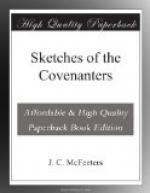Richard Cameron had fallen in the battle at Ayrsmoss; but the cause had not failed, nor would he be forgotten. “The righteous shall be in everlasting remembrance.” His years were brief, but his work was great. He was fresh and hearty, in the very prime of his life when he met death. The sun had only reached the meridian of his sky. While his powers were glowing with divine energy, and his ministry was making the deepest impression, the Lord called him home to glory. The translation from earth to heaven was sudden and sublime. One of the poets has painted his own conception of the event in a brilliant poem, entitled, “The Cameronian’s Dream.” That noble life, so full of zeal, action, and power, left a lasting imprint on the Church of the Covenanters. So mighty was his influence that the people who stood strictly to the Covenant were henceforth called Cameronians.
The field of Ayrsmoss presented a sad sight that evening. The departing day may have flung over it a glowing sunset, but nothing could relieve the gloom. The light was fading as the dragoons left, taking with them Captain Hackston and a few other bleeding prisoners. Night settled softly upon the moorland; the shout of the captains had given place to the stillness of death. Nine noble defenders of the Covenant lay pulseless in the dewy grass. The friends, soon as safety permitted, came and, gathering the bodies together, solemnly and sadly buried them in one broad grave. The present monument marks the spot where the precious dust awaits the resurrection.
The head and hands of Cameron were cut off and carried in ignoble triumph through the streets of Edinburgh. The head was elevated on the point of a spear and borne in front of the prisoners to the city jail. Cameron’s father was a prisoner there at that time. The head and hands were presented to him, with the sneering question, “Do you know them?” The aweful shock quickly gave place to a gush of fatherly affection. The blood, the pallor, even the stare of the lifeless face, seemed to disappear in the heart-kindlings of the aged parent; to him the countenance was sweet as ever, the eyes were beaming, the lips were vocal, the brow was wreathed with holy dignity. A thousand tender scenes of the past must have rushed in upon the soul of the agitated father. He took up the cold pieces, dearer to him than his own flesh and, while tears flowed plentifully, kissed them, saying, “I know them; they are my son’s; my own dear son’s: the Lord can harm neither me nor mine; good is the will of the Lord.”
Cameron lived in the most critical period of the Covenanted cause. His life of service and sacrifice arose into gigantic strength just when the Covenanted Reformation seemed to be ready for burial. The floodtide of Indulgence had almost submerged the testimony of the Covenanters. Many of the ministers had been caught in that Satanic snare. The remainder were overawed, or disabled with disease and old age. Yet there was a host of brave men and honorable women, thousands in number, who without a leader faced the increasing’ fierceness of the persecution, and continued their testimony for Christ in defiance of the king’s wrath. These were called the Society People, and Cameron during his public ministry was their standard-bearer.




